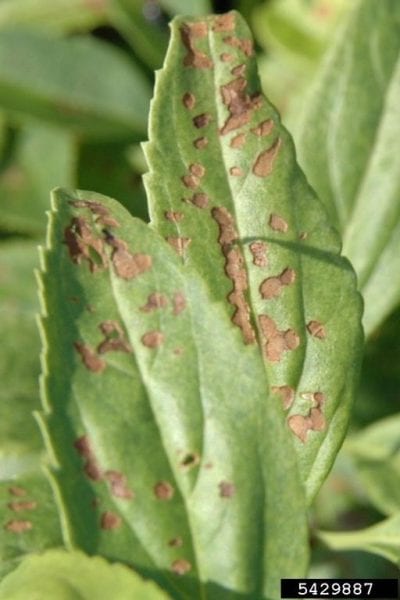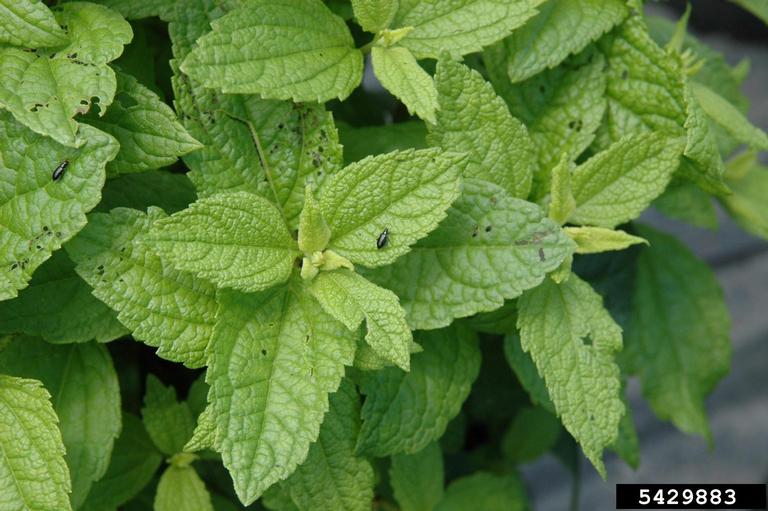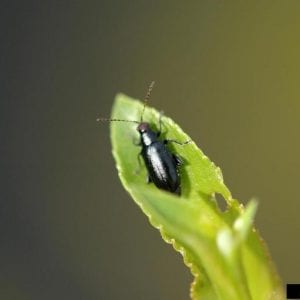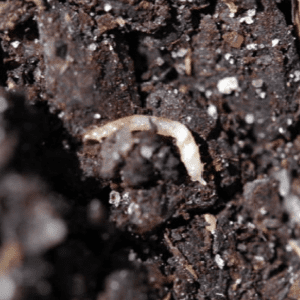Crop Production

The redheaded flea beetle has been reported statewide in Alabama since the 70s. Severe outbreaks of this species in nurseries have been reported over the last 10 to 15 years. To gauge pest severity and an understanding of the biology, an Auburn University researcher interviewed a focus group of Alabama growers with experience battling this pest.
Description and Biology
Flea beetles have enlarged hind legs, suitable for jumping from plant to plant. The adult redheaded flea beetle is the only common flea beetle in nurseries with a reddish-orange head (Figure 1a). The larvae are elongated, white, and small (Figure 1b). Their biology is similar to that of the strawberry rootworm, where the eggs and larvae are found in the soil or potting medium and the adults feed on leaves.
- Figure 1a. Adult redheaded flea beetle. Image by Brian Kunkel, University of Delaware, Bugwood.org
- Figure 1b. Redheaded flea beetle larva. Image by Brian Kunkel, University of Delaware
These beetles generally appear April through June, depending on the area of the state and the severity of the previous winter. In south Alabama, damage typically continues through September and October, but growers in central and north Alabama note little to no damage after late June or early July. In states along the gulf, the number of generations that appear and the stage in which they overwinter is unknown. However, in northern states, they overwinter as eggs, which hatch in spring. At least two generations are reported in northern states.
Hosts
These beetles have a wide range of hosts. However, they have definite likes and dislikes. Researchers have observed that they begin feeding on newly flushing deciduous plants, like hydrangea, weigela, or Itea, then move to evergreens, like hollies, later in the year. In addition to these species, salvia, hibiscus, and forsythia are also hosts. They have been known to prefer certain species and cultivars within these plant groups. For example, they will usually attack Limelight hydrangea (a paniculata species) before other hydrangeas. They also rarely cause damage to varieties of Hydrangea macrophylla. These beetles may also use weeds as a host before moving into a nursery. However, there is no research suggesting that aggressive weed control will prevent or eliminate pest problems. Weed hosts can include
- dogfennel
- pigweed
- knotweed
- giant ragweed
- Virginia buttonweed
- smartweed
- eclipta
Damage Caused

Figure 2. Adult redheaded flea beetle feeding damage. Image by Brian Kunkel, University of Delaware, Bugwood.org
The redheaded flea beetle causes an interesting pattern of damage on plants. While larvae do not cause noticeable damage on plants, adults will feed on the plant and often do not chew through the leaf. This produces a brown spot that could be mistaken for sunken lesions of a leaf disease (Figure 2). These spots can become severe enough to prevent plants from being sold, but they are almost never severe on landscaping plants.
Growers report ‘chasing’ the beetles from block to block in nurseries. It is thought that adult beetles may seek plants with new growth, moving to other plants as they flush new growth. The reason for this may be related to nitrogen content. They may cruise the nurseries until they find a plant with their preferred level of foliar nitrogen. They then consume the plant until either controlled or the plant is defoliated. Consuming the leaves from fertilized plants can improve the survival of adults or produce more offspring.
Scouting and Control
If seen, growers will usually see the larvae around the edge of the potting medium when a plant is pulled from the container. Damage to the leaves is the obvious sign of an infestation because larvae cause no noticeable signs of damage. When this species outbreaks in nurseries, producers have a limited number of options for scouting before damage occurs. Unfortunately, yellow sticky cards do not detect the first emerging beetles. Some researchers say beetles are not captured on these until after there is significant damage to plants. For this reason, producers rely on insecticides to prevent damage and losses.
Insecticides target either the leaf-feeding adults or root-feeding larvae. Information from the focus group showed that growers mostly target adults using systemic insecticides such as imidacloprid, dinotefuran, acetamiprid, cyantraniliprole, or cyclaniliprole. These materials are applied to plants as a sprench, drench, granular application, or incorporated into the growing medium. Soil applications are labor intensive and the timing conflicts with spring shipping schedules. If a product is labeled for pre-plant applications, producers can avoid the time conflict by incorporating those insecticides into the potting medium or make pre-egg hatch applications.
Even with systemic activity, insecticides may only provide 10 to 21-day control from a single application. Many producers rotate different foliar-applied materials every 10 to 17 days. Synthetic pyrethroids, carbaryl, Ultra-Pure oil, or spinosad are also being used for a quick knockdown. Some retailers do not want plants treated with neonicotinoid insecticides. Because of this, some growers are using biological controls, specifically insect pathogenic nematodes, to control larvae in pots. However, additional research is needed to improve the timing and delivery method for these beneficial nematodes.
Research
Growers can contribute to the on-going research about redheaded flea beetles. If interested, complete a short survey through the University of Georgia website.
Featured image by Brian Kunkel, University of Delaware, Bugwood.org



